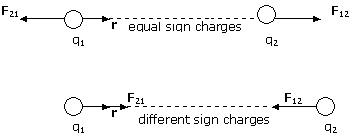The French engineer Charles Coulomb investigated the quantitative relation of forces between charged objects during the 1780's. Using a torsion balance device, created by Coulomb himself, he could determine how an electric force varies as a function of the magnitude of the charges and the distance between them.
Coulomb used little spheres with different charges whose exact value he did not know, but the experiment allowed him to test the relation between the charges. Coulomb realized that if a charged sphere touches another identical not charged sphere, the charge will be shared in equal parts symmetrically. Thus, he had the way to generate charges equal to ½, ¼, etc., from the original charge. Keeping the distance constant between the charges he noticed that if the charge of one of the spheres was duplicated, the force was also duplicated; and if the charge in both spheres was duplicated, the force was increased to four times its original value. When he varied the distance between the charges, he found the force decreased in relation to the square of the distance; that is, if the distance was duplicated, the force decreased to the fourth part of the original value.In that way Coulomb demonstrated that the
electric force between two stationary charged particles is :
- Inversely proportional to the square of the distance r between the particles
and is directed along the line that joins them.
- Proportional to the product of the charges q1 and q2.
- Attracted if the charges have opposite electrical sign and repulsed if the
charges have equal sign.
Coulomb 's Law can be expressed in the form of an equation :
![]()

The validity of Coulomb's Law has been verified
with modern devices that have detected that the exponent 2 has an exactitude
of one part in 1016.
Ke is a constant known as the Coulomb 's constant, which in the
International System units has the value Ke = 8.987x109
Nm2/C2.
The International System unit for charge is the Coulomb.
The smallest known charge in nature is the charge of an electron or proton,
which has an absolute value of e = 1.60219x10-19 C.
Thus, a 1 Coulomb charge is approximately equal to a charge of 6.24x1018
(= 1C/e) electrons or protons.
We should notice that the force is a vectorial
quantity, that is, has magnitude and direction. Coulomb 's Law expressed in
vectorial form for the electric force F12 exerted by a charge q1
over a second charge q2 is (bold type is used to denote vectorial
quantities):
![]()
![]()
![]()

As every force obeys Newton's third Law, the electric force exerted by q2 over q1 is equal in magnitude to the force exerted by q1 over q2 and in the opposite direction, that is F21= - F12.
If q1 and q2 have the same sign, F12 takes the direction of r. If q1 and q2 have opposite sign, the product q1q2 is negative and F12 points opposite to r.
When two or more charges are present, the force between any pair of them is given by the above equation. Hence, the resultant force on any of them is equal to the vectorial sum of the forces exerted by the different individual charges. For example, with three charges, the resultant force exerted by particles 2 and 3 over 1 is
F1 = F21 + F31
Most Related Sites
· Coulomb's
Law Exercises
· Energy, Work
and Power: Concepts
· Power
· Kinetic
Energy
· Potential
Energy
Related Sites:
· Physics, Main Page
· Physics, Mathematics
· Physics, Detailed Homework Scope Help
· Energy, Work and Power: Concepts
· Kinetic Energy
· Potential Energy
· Power
· Ohm's Law, Principle
· Ohm's Law Exercises
· Gauss' Law
· Gauss' Law Exercises
· Second Newton's Law
· Second Newton's Law Examples, Part One
· Second Newton's Law Examples, Part Two
· Physics Problems, Example
· Physics Homework - Mechanical Energy Conservation Problems
· Physics Homework - Mechanical Power Problems
· Electric Field Charges
· Electric Field Exercises
· Electric Potential Energy
· Exercises, Electric Potential Energy
· Sound Waves
· Sound Waves: Standing, Interference, Doppler Effect - Examples
· Vectors, Scalars
· Vectors, Scalars - Analytic Method
· Addition Vector Tools, Problems
· Free Fall Theory
· Free Fall Exercises, Part One
· Free Fall Exercises, Part Two
· Free Fall Exercises, Part Three